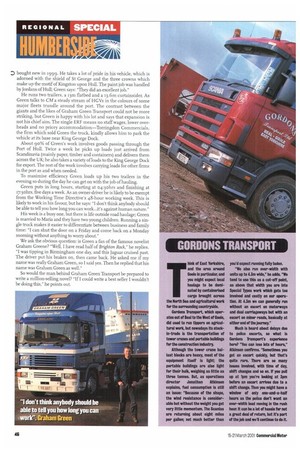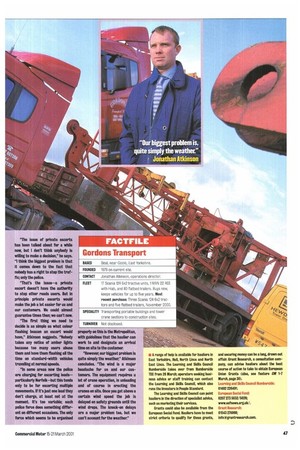hink of East Yorkshire, and the area around Goole in
Page 48

Page 49

If you've noticed an error in this article please click here to report it so we can fix it.
particular, and you might expect local haulage to be dominated by containerised cargo brought across the North Sea and agricultural work for the surrounding countryside.
Gardens Transport, which operates out of Beal to the West of Goole, did used to run tippers on agricultural work, but nowadays its stockin-trade is the transportation of tower cranes and portable buildings for the construction industry.
Although the tower crane ballast blocks are heavy, most of the equipment itself is light; the portable buildings are also light for their bulk, weighing as little as three tonnes. But, as operations director Jonathan Atkinson explains, fuel consumption Is still an issue: "Because of the shape, the wind resistance is considerable but without the weight you get very little momentum. The Scanias are returning about eight miles per gallon; not much better than you'd expect running fully laden.
"We also run over-width with units up to 4.3m wide," he adds. "We tend to use this as a cut-off point, as above that width you are into Special Types work which gets too involved and costly on our operation. At 4.3m we can generally run without an escort on motorways and dual carriageways but with an escort on minor roads, basically at either end of the journey."
Much is heard about delays due to police escorts, so what is Cordons Transport's experience here? "You can lose lots of hours," Atkinson confirms. "Sometimes you get an escort quickly, but that's quite rare. There are so many issues involved, with time of day, shift changes and so on. If you pull up at lpm you're looking at 3pm before an escort arrives due to a shift change. Then you might have a window of only one-and-a-half hours as the police don't want an over-width load moving in the rush hour. It can be a lot of hassle for not a great deal of return, but it's part of the job and we'll continue to do it. "The issue of private escorts has been talked about for a while now, but I don't think anybody is willing to make a decision," he says. "I think the biggest problem is that it comes down to the fact that nobody has a right to stop the traffic; only the police.
"That's the issue—a private escort doesn't have the authority to stop ether roads users. But in principle private escorts would make the job a lot easier fbr us and our customers. We could almost guarantee times then; we can't now "The first thing we need to decide is as simple as what colour flashing beacon an escort would have," Atkinson suggests. "Nobody takes any notice of amber lights because too many users abuse them and have them flashing all the time on standard-width vehicles travelling at normal speeds,
"In some areas now the police are charging for escorting loads— particularly Norfolk—but this tends only to be for escorting multiple movements. If it's just one load they don't charge, at least not at the moment. It's too variable; each police force does something different on different occasions. The only force which seems to be organised
properly on this is the Metropolitan, with guidelines that the haulier can work to and designate an arrival time on site to the customer.
"However, our biggest problem Is quite simply the weather," Atkinson concludes. "The wind is a major headache for us and our customers. The equipment requires a lot of crane operation, in unloading and of course in erecting the cranes an site. Once you get above a certain wind speed the job is delayed an safety grounds until the wind drops. The knock-on delays are a major problem too, but we can't account for the weather."












































































































